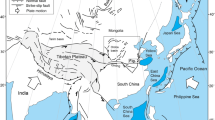Abstract
The increasing number of earthquakes in recent decades in Northwestern Iran and the determination of the epicenters of these events makes possible to estimate accurately the changing tectonic regime using the Win-Tensor inversion focal mechanism program. For this purpose focal mechanism data were collected from various sources, including the Centroid Moment Tensor catalog (CMT). The focal mechanism and fault slip data were analyzed to determine change in the stress field up to the present day. The results showed that two stages of brittle deformation occurred in the region. The first stage was related to Eocene compression in NE–SW direction, which created compressional structures with NW–SE strike, including the North and South Bozgush, south Ahar and Gushedagh thrust belts. The second brittle stage began in the Miocene with NW–SE compression and caused developing thrusts with N–S trends that were active presently. These stress regimes were created by the counter-clockwise rotation of the Azerbaijan plateau caused by movement on strike slip faults and continuous compression between the Arabian plate, the south Caspian basin and the Caucasus region. Pliocene-Quaternary activity of the Sabalan and Sahand volcanoes as well as recent earthquakes occurred as a result of this displacement and rotational movement. The abundance of hot springs in the Ardebil, Hero Abad and Bostanabad areas also bore witness to this activity.
Similar content being viewed by others
References
A. Aghanabati, in Geology of Iran (Geological Survey of Iran, Tehran, 2004), pp. 211–310.
M. Allen, J. Jackson, and R. Walker, “Late Cenozoic reorganization of the Arabia-Eurasia collision and the comparison of short-term and long-term deformation rates,” Tectonics 23 (2), Pap. No. TC2008 (2004). doi 10.1029/2003TC001530
N. N. Ambraseys, “The Krasnovodsk (Turkmenistan) earthquake of 8 July 1895,” J. Earthquake Eng. 1, 293–317 (1997).
L. Angelier, “Faults slip analysis and paleostress reconstruction,” in Continental Deformation, Ed. by P. L. Hancock (Pergamon, Oxford, 1994), pp. 110–120.
G. J. Axen, P. S. Lam, M. Grove, D. F. Stockli, and J. Hassanzadeh, “Exhumation of the west-central Alborz mountains, Iran, Caspian subsidence and collision-related tectonics,” Geology 29, 559–562 (2001).
C. Baker, PhD Thesis (Univ. Cambridge, Cambridge, U.K., 1993).
A. Barth, PhD Thesis (Univ. Karlsruhe, Karlsruhe, 2007).
E. Carey-Gailhardis and P. Vergely, “Graphical analysis of fault kinematics and focal mechanisms of earthquakes in term of stress; the right dihedral method, use and pitfalls,” Ann. Tecton. 1, 3–9 (1992).
CMT (Centroid Moment Tensor catalog), Harvard University, Department of Geological Sciences, 2006. http://www.globalcmt.org/CMTsearch.html.
D. Delvaux, R. Moeys, G. Stapel, C. Petit, K. Levi, A. Miroshnichenko, V. Ruzhich, and V. San’kov, “Paleostress reconstructions and geodynamics of the Baikal region, Central Asia, Part II: Cenozoic rifting,” Tectonophysics 282, 1–38 (1997).
D. Delvaux and B. Sperner, “Stress tensor inversion from fault kinematic indicators and focal mechanism data: The TENSOR program,” in New Insights into Structural Interpretation and Modelling, Vol. 212 of Geol. Soc. London, Spec. Publ., Ed. by D. Nieuwland (London, 2003), pp. 75–100.
J. F. Dewey, M. R. Hampton, W. S. F. Kidd, F. Saroglu, and A. M. C. Sengör, “Shortening of continental lithosphere: The neotectonics of eastern Anatolia, a young collision zone,” in Collision Tectonics, Vol. 19 of Geol. Soc. London Spec. Publ., Ed. by M. P. Coward and A. C. Ries (London, 1986), pp. 1–36.
J. W. Gephart and D. W. Forsyth, “An improved method for determining the regional stress tensor using earthquake focal mechanism data: Application to the San Fernando earthquake sequence,” J. Geophys. Res., B 89, 9305–9320 (1984).
O. Heidbach, M. Tingay, A. Barth, J. Reinecker, and B. Muller, “Global spatial wave-length analysis of the tectonic intraplate stress pattern,” Tectonophysics 482, 3–15 (2010).
M. R. Hempton, “Constrains on Arabian plate motion and extensional history of the Red Sea,” Tectonics 6, 687–705 (1987).
B. Lund and J. Townend, “Calculating horizontal stress orientations with full or partial knowledge of the tectonic stress tensor,” Geophys. J. Int. 170, 1328–1335 (2007).
F. Masson, J. Martinod, D. Hatzfeld, P. Vernant, F. Tavakoli, and A. Ashtiani, “Seismic versus aseismic deformation in Iran inferred from GPS and Seismicity data,” Geophys. J. Int. 160, 217–226 (2005).
J. L. Mercier and E. Carey-Gailhardis, “Paleostress determinations from fault kinematics: Application to the neotectonics of the Himalayan-Tibet and the central Andes,” Philos. Trans. R. Soc. London, Ser. A 337, 41–52 (1991).
Z. Mousavi, A. Walpersdorf, R. T. Walker, F. Tavakoli, E. Pathier, H. Nankali, F. Nilfouroushan, and Y. Djamour, “Global Positioning System Constrains on the active tectonics of NE Iran and South Caspian region,” Earth Planet. Sci. Lett. 377–378, 287–298 (2013).
J. G. Ramsay and M. I. Huber, in The Techniques of Modern Structural Geology, Vol. 1: Strain Analysis (Academic Press, London, 1983), pp. 73–105.
S. Rebai, H. Philip, L. Dorbath, B. Borissoff, H. Haessler, and A. Cisternas, “Active tectonics in compressive and extensional structures,” Tectonics 12, 1089–1114 (1993).
M. Talebian and J. Jackson, “Offset on the main recent fault of NW Iran and implications for the late Cenozoic tectonics of the Arabia-Eurasia collision zone,” Geophys. J. Int. 150, 422–439 (2003).
M. Tekin, “Iranian geology and continental drift in the Middle East,” Nature 235, 147–150 (1972).
B. Zamani, “Tectonic model of Azerbaijan plateau (North of Tabriz fault and South Aras),” Geoscience (Iran) 22, 41–50 (2013).
B. Zamani, J. Angelier, and A. Zamani, “State of stress induced by plate convergence and stress partitioning in northeastern Iran, as indicated by focal mechanisms of earthquakes,” J. Geodyn. 45, 120–132 (2008).
M. L. Zoback, “First- and second-order patterns of stress in the lithosphere: The world stress map project,” J. Geophys. Res.: Solid Earth 97, 11703–11728 (1992).
Author information
Authors and Affiliations
Corresponding author
Additional information
The article is published in the original.
Rights and permissions
About this article
Cite this article
Alizadeh, A., Hoseynalizadeh, Z. Analysis of the stress regime and tectonic evolution of the Azerbaijan Plateau, Northwestern Iran. Geotecton. 51, 308–318 (2017). https://doi.org/10.1134/S0016852117030037
Received:
Published:
Issue Date:
DOI: https://doi.org/10.1134/S0016852117030037




